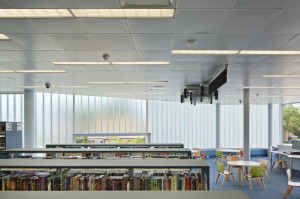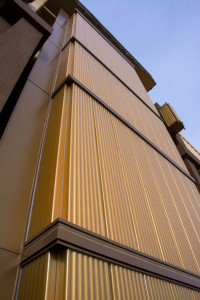
Photo © Eduard Huber/Arch Photo Inc.
Channel glass insulation
As described in Part One, channel glass’ configuration helps combat excessive heat gain or loss to improve occupant comfort. The individual glass segments can be mounted in an overlapping fashion to create an insulating dead-air-filled space and thermal gap. This arrangement results in a solar heat-gain coefficient (SHGC) of approximately 0.70 and a U-value of 0.49.
While functional, the channel glass cavity is also a tool for design teams to improve energy efficiency. By specifying insulation within the channel glass’ air-filled space, design professionals can further reduce heat loss and minimize solar heat gain. One of the most effective materials for this is aerogel insulation.
Aerogel is a highly porous, non-hazardous silica that is made of 95 percent air. It is, therefore, translucent and exceptionally lightweight. In channel glass systems, it is encased in 16-mm (0.6-in.) or 25-mm (0.9-in.) polycarbonate panels that are held inside the channel glass cavity with snap-on centering clips. This configuration helps protect the aerogel from exposure to moisture, dirt, and other debris. When placed inside channel glass’ air-filled gap, it can help reduce the SHGC to 0.31 and the U-value to 0.19 with marginal impacts on light transmission. As an added benefit, aerogel insulation can help minimize unwanted noise, resulting in a sound transmission class (STC) of 44.
Aerogel can be installed in dual-glazed channel glass systems in vertical, horizontal, or curved/serpentine configurations.
Functional coatings
Channel glass is also available with functional coatings to meet specific project demands. Popular options include low-emissivity (low-e), solar, and high-performance color coatings.
Low-e coating
Channel glass with a low-e coating can increase the energy efficiency of the system by improving the glass’ U-value. It accomplishes this by reflecting infrared light (i.e. heat energy) back into the building during the cold months, and reflecting or absorbing energy from the outside to reduce the amount of excess heat coming into the building during the summer. As a result, uninsulated channel glass with a low-e coating can reduce the U-value to 0.45.
While a low-E coating can be applied to all available channel glass textures, it cannot be sandblasted as this will strip the coating off, eliminating the performance benefit.

Solar coating
Channel glass with a solar coating helps reduce the total solar radiation transmittance into the building, resulting in an approximate SHGC value of 0.38. It is translucent with a slight bronze tint, and can be applied to all available channel glass textures. As with low-e coatings, it cannot be sandblasted.
Durable color coating
Channel glass with a high-performance color coating does not require tempering, and is bonded to the glass with high adhesion strength to resist chipping and fading. It is available in a wide array of opaque and metallic colors with varying translucency to match the building’s color scheme, and can be applied to standard and low-iron channel glass options in all available textures. For added protection and opacity, design teams can specify an optional flood coating.
High-performance color coatings are ideal for channel glass walls, façades, or partitions where long-lasting, colorfast beauty is central to the project. This was the case for the Hollywood Casino in Columbus, Ohio, where the design intent was to capture the golden age of Hollywood from the outside of the building in. To create this aesthetic, Marnell Architects specified low-iron, wave-shaped channel glass with a translucent, metallic gold, high-performance coating. The metallic coating and wave-shaped texture of the channel glass intensify color and light to form optical variations for casino visitors, and create an exterior that sparkles gold both day and night.
Conclusion
While channel glass first became popular for its ability to diffuse natural light into buildings, it continues to gain traction for its multifaceted design and performance benefits. It is one of the few modern glazing materials that can stand up to Mother Nature, transfer daylight, and preserve a building’s original design intent. To learn more about using channel glass to its full potential in building design, one can contact a channel glass manufacturer or supplier for the latest information, code updates, and design support.
 Jeff Razwick is the president of Technical Glass Products (TGP), a supplier of fire-rated glass and framing systems, and other specialty architectural glazing. He writes frequently about the design and specification of glazing for institutional and commercial buildings. Razwick is a past-chair of the Glass Association of North America’s (GANA) Fire-Rated Glazing Council (FRGC). He can be contacted via e-mail at jeffr@fireglass.com.
Jeff Razwick is the president of Technical Glass Products (TGP), a supplier of fire-rated glass and framing systems, and other specialty architectural glazing. He writes frequently about the design and specification of glazing for institutional and commercial buildings. Razwick is a past-chair of the Glass Association of North America’s (GANA) Fire-Rated Glazing Council (FRGC). He can be contacted via e-mail at jeffr@fireglass.com.




